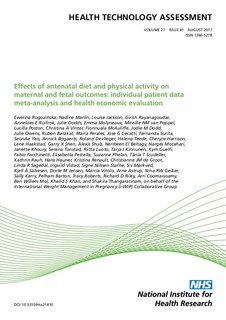Effects of antenatal diet and physical activity on maternal and fetal outcomes: Individual patient data meta-analysis and health economic evaluation
Rogozińska, Ewelina; Marlin, Nadine; Jackson, Louise; Rayanagoudar, Girish; Ruifrok, Anneloes E.; Dodds, Julie; Molyneaux, Emma; van Poppel, Mireille N.M.; Poston, Lucilla; Vinter, Christina Anne; McAuliffe, Fionnuala; Dodd, Jodie M.; Owens, Julie; Barakat, Ruben; Perales, Maria; Cecatti, José Guilherme; Surita, Fernanda; Yeo, Seon Ae; Bogaerts, Annick; Devlieger, Roland; Teede, Helena; Harrison, Cheryce; Haakstad, Lene Annette Hagen; Shen, Garry X.; Shub, Alexis; El Beltagy, Nermeen; Motahari, Narges; Khoury, Janette; Tonstad, Serena; Luoto, Riitta; Kinnunen, Tarja I.; Guelfi, Kym; Facchinetti, Fabio; Petrella, Elisabetta; Phelan, Suzanne; Scudeller, Tânia T.; Rauh, Kathrin; Hauner, Hans; Renault, Kristina; de Groot, Christianne J.M.; Sagedal, Linda Reme; Vistad, Ingvild; Stafne, Signe Nilssen; Mørkved, Siv; Salvesen, Kjell Å; Jensen, Dorte M.; Vitolo, Márcia; Astrup, Arne; Geiker, Nina Rica Wium; Kerry, Sally; Barton, Pelham; Roberts, Tracy; Riley, Richard D.; Coomarasamy, Arri; Mol, Ben Willem; Khan, Khalid S.; Thangaratinam, Shakila
Peer reviewed, Journal article
Published version
Permanent lenke
http://hdl.handle.net/11250/2498703Utgivelsesdato
2017Metadata
Vis full innførselSamlinger
- Artikler / Articles [2119]
Sammendrag
Background: Diet- and physical activity-based Interventions in pregnancy have the potential to alter
maternal and child outcomes. Objectives: To assess whether or not the effects of diet and lifestyle interventions vary in subgroups of women, based on maternal body mass index (BMI), age, parity, Caucasian ethnicity and underlying medical condition(s), by undertaking an individual patient data (IPD) meta-analysis. We also evaluated the association of gestational weight gain (GWG) with adverse pregnancy outcomes and assessed the cost-effectiveness of the interventions. Data sources: MEDLINE, EMBASE, Cochrane Central Register of Controlled Trials, Database of Abstracts of Reviews of Effects and Health Technology Assessment database were searched from October 2013 to March 2015 (to update a previous search). Review methods: Researchers from the International Weight Management in Pregnancy Collaborative Network shared the primary data. For each intervention type and outcome, we performed a two-step IPD random-effects meta-analysis, for all women (except underweight) combined and for each subgroup of interest, to obtain summary estimates of effects and 95% confidence intervals (CIs), and synthesised the differences in effects between subgroups. In the first stage, we fitted a linear regression adjusted for baseline (for continuous outcomes) or a logistic regression model (for binary outcomes) in each study separately; estimates were combined across studies using random-effects meta-analysis models. We quantified the relationship between weight gain and complications, and undertook a decision-analytic model-based economic evaluation to assess the cost-effectiveness of the interventions. Results: Diet and lifestyle interventions reduced GWG by an average of 0.70 kg (95% CI –0.92 to –0.48 kg; 33 studies, 9320 women). The effects on composite maternal outcome [summary odds ratio (OR) 0.90, 95% CI 0.79 to 1.03; 24 studies, 8852 women] and composite fetal/neonatal outcome (summary OR 0.94, 95% CI 0.83 to 1.08; 18 studies, 7981 women) were not significant. The effect did not vary with baseline BMI, age, ethnicity, parity or underlying medical conditions for GWG, and composite maternal and fetal outcomes. Lifestyle interventions reduce Caesarean sections (OR 0.91, 95% CI 0.83 to 0.99), but not other individual maternal outcomes such as gestational diabetes mellitus (OR 0.89, 95% CI 0.72 to 1.10), pre-eclampsia or
pregnancy-induced hypertension (OR 0.95, 95% CI 0.78 to 1.16) and preterm birth (OR 0.94, 95% CI 0.78 to 1.13). There was no significant effect on fetal outcomes. The interventions were not cost-effective. GWG, including adherence to the Institute of Medicine-recommended targets, was not associated with a reduction in complications. Predictors of GWG were maternal age (summary estimate –0.10 kg, 95% CI –0.14 to –0.06 kg)
and multiparity (summary estimate –0.73 kg, 95% CI –1.24 to –0.23 kg). Limitations: The findings were limited by the lack of standardisation in the components of intervention,
residual heterogeneity in effects across studies for most analyses and the unavailability of IPD in some studies.
Conclusion: Diet and lifestyle interventions in pregnancy are clinically effective in reducing GWG irrespective of risk factors, with no effects on composite maternal and fetal outcomes. Future work: The differential effects of lifestyle interventions on individual pregnancy outcomes need evaluation.
Beskrivelse
This work was produced by Rogozin´ ska et al. under the terms of a commissioning contract issued by the Secretary of State for Health. This issue may be freely reproduced for the purposes of private research and study and extracts (or indeed, the full report) may be included in professional journals provided that suitable acknowledgement is made and the reproduction is not associated with any form of advertising. Applications for commercial reproduction should be addressed to: NIHR Journals Library, National Institute for Health Research, Evaluation, Trials and Studies Coordinating Centre, Alpha House, University of Southampton Science Park, Southampton SO16 7NS, UK.
